Ruth Patir’s I dream of the elections at Danspace and Isadora Duncan in the 21st Century at the 92 Y Harkness Dance Center.
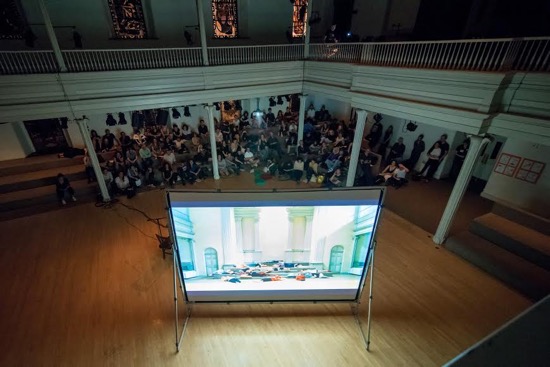
Audience in Saint Marks Church for Ruth Patir’s I dream of the elections and screen showing (filmed) performers on the altar steps. Photo: Ian Douglas
In troubled times, we do strange things and see familiar ones differently. On Thursday night, January 19, 2017, I enter Saint Mark’s Church through the “wrong” door, because of construction work on the main entrance. From this small room, where occasionally during past years I got ready to perform, I can see through the inner door to the sanctuary. Men and women are sleeping on the steps to the altar. Oh, good, I think, maybe there’s more dancing than I expected in Danspace Project’s presentation of Ruth Patir’s I dream of the elections, the kickoff to the following afternoon and evening array of related classes, workshops, screenings, performances, discussions, and an installation—all masterminded by Patir.
When I get to my seat, I realize that those are not flesh-and-blood performers lying on the carpeted steps. Recently, they did lie there, and Patir’s director of photography, Boaz Freund, filmed them; that film has been projected onto the steps with almost perfect spatial correspondences. If one of the sleepers hadn’t stretched an arm once, I would have thought the vision a still photograph. In fact, Patir is the only living human being onstage during the evening.
While waiting for the beginning (?) of the performance to be signaled by the church’s 8 P.M. bells, we can peruse Patir’s 2016 Sleep w/Me: film loops that play over and over—one on a large screen set diagonally and one on the wall that backs the altar platform. The one on the screen periodically announces itself in a title reading “Obama gif 1. mp 4.” The gif shows a man we assume to be Obama, walking away from us, down a corridor toward a distant door. He never gets there; with a slight burp in the image, an identical one replaces it. Over and over and over and over. . . . The projection on the wall replays a several-image sequence; it takes a while to identify some of its components. The same trudger, a white disk of light, a brown substance glistening with water, hands molding brown clay on a potter’s wheel, a close-up of a handsome, sensitive, intent face that is surely Barack Obama (Luis Ortiz is billed as BronxObama; if that’s his face, the likeness is remarkable). Later, we will see the same man, slumped by the wheel, tired out. Impossible to avoid thinking of Obama trying to build and maintain structures that are about to be washed away.
In Sleepers (2017)—directed by Patir, with Leah Moscowitz as Director of Photography— the screen first shows three of the seventeen performers chatting at St. Mark’s. They talk of dreams, penises, vaginas, and De Toqueville. One of them google-dives for information they need. The next scene is of a group of them, shot from above, lying head-to-head in a circle, faces up. Various individuals recall dreams in which Obama or Hilary Clinton figure, after which another person asks a question or makes a comment. I enjoy watching one prominently placed woman; she occasionally rolls her eyes.
Both these works have effective sound scores that include echoing footsteps. Shay Bakar designed the one for Sleep w/Me, Jackson Randall is credited with musical contributions for Sleepers and John Furher for its sound mix.
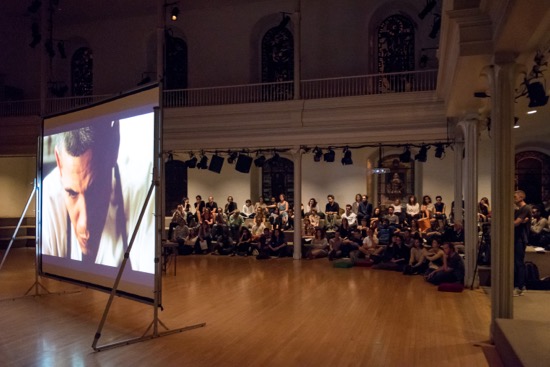
Obama intent. Ruth Patir’s Sleep w/ Me at Danspace Saint Marks. Photo: Ian Douglas
Much later we learn of “The Soul Dreamers Club;” maybe these people belong to it. When they sit in a ring, each massaging the shoulders of the person in front of him/her, the dream memories assume a ritual form. A responder to each says, “If it were my dream, I would. . . .” This is not an improvisation. The dreams were collected and/or written by the Canadian author Sheila Heti in 2008. (idreamofhilary.blogspot.com and idreamofbarack.blogspot.com). Some of these, printed on pink or blue paper, lie scattered on the floor near the spectators. Like all dreams, these are wild, improbable, funny, and sad. Dream 53 (on a pink paper) belonged to a woman with a new grandson; she is visited by Obama and a woman she used to know; like Lady Godiva, this woman is stark naked, long red hair her only clothing. They’ve come “to pick up the baby.” My blue paper, number 125, also gathered at random, details the dream of a history professor. He is in a game of seven-card stud with Hilary Clinton; highly irregular moves and transformative events seem normal. In the end, Clinton refuses to accept his hand “as a (higher) flush,” and takes the pot.
The program notes on Patir’s project read in part, “she asks us to transform our night dreams into a site of political intervention, considering society’s social subconscious through the act of sleep.” Would you ever have believed that many, many people dream of encounters with political figures?
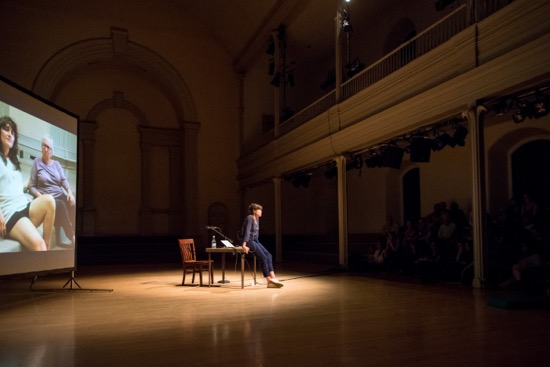
Ruth Patir with some of her onscreen performers in I dream of elections. Photo: Ian Douglas
Patir herself appears—informal but intense, charming. She sits on the table holding the laptop, occasionally pressing a button. Around the time she starts to talk to us, she cues a photo of Obama and Clinton hugging each other; it reminds us of what could have been (should have been, given the popular vote). She introduces (on film) glamorous celebrity dream expert Lauri Loewenberg and then conducts (also on film) an interview with dream interpreter Lauren Lawrence (the multiples “L”s seem to be coincidental), with Patel’s questions printed onscreen. I glance at Patir, who watches Lawrence skeptically (also mentioning in an aside that this woman is friends with a number of right-wingers). According to Lawrence, dreams pump up our brains. Patir also speaks of Kelly Bulkeley and shows his image (a handsome dude); he’s a psychologist who received a doctorate from the University of Chicago Divinity School, has specialized in dream research, and written many books on the topic. Apparently election years induce a flood of dreams. You can read his remarks, as well as dreams he has culled in 2016 at http://www.huffingtonpost.com/kelly-bulkeley-phd/the-13-most-thought-provo_b_12566564.html.
Patir offers so much material that it’s hard to tell what she admires and what she questions. Do rich people really sleep better? Do democrats really dream more? Finally, she asks if any spectators want to tell their election-year dreams. A few do. One man’s recollection contains an unforgettable image (I hope I’ve got it right). Donald Trump is walking along in control of two bears on chains; the dreamer imagines that the bears represent the United States Senate and the House of Representatives.
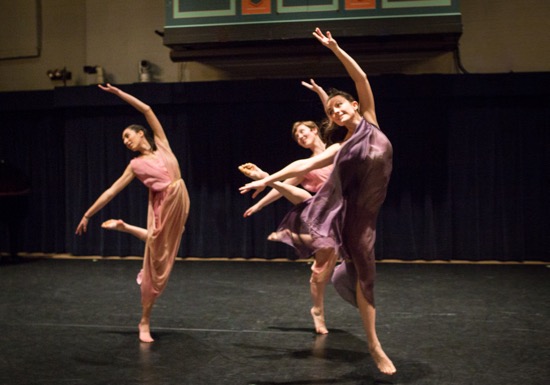
L to R: Ella Lang, Amelia Sanders and Jessie King of Dances by Isadora in Isadora Duncan’s Mazurka in D major. Photo Yi-Chun Wu
January 20, 2017. Well before noon, I’m on my way to the 92nd Street YM-YWHA’s Buttenweiser Hall for one of the Fridays at Noon curated by Catherine Tharin. Is this escapism on my part? I don’t think so. The title of the afternoon, “Isadora Duncan in the 21st Century,” is also the title of Andrea Mantell Seidel’s new book, and Seidel introduces the afternoon, first as a dancer, performing a gravely maternal excerpt from Duncan’s Ave Maria (ca. 1914), assisted by two members of her Isadora Duncan Dance Ensemble (the group is based in Miami, where Seidel is a professor at Florida International University). (Disclosure: Seidel graciously presented me with a signed copy of her book).
Why invoke Isadora on Inauguration Day? That was clear to me, but became clearer over the course of the performance. For a woman born in 1877, Duncan was a free spirit and a radical one. She altered current ideas about women’s bodies onstage; she countered ballet with movement based in, or alluding to nature. And she spoke and wrote her ideas about art and freedom and women’s position in society, linking dancing not just with entertainment, but with the gods and heroes of Greek myth and with philosophers like Nietzsche and Schopenhauer. She dared to dance to the music of great composers. She went to Moscow in 1921 at the behest of Anatole Lunacharsky, the People’s Commissar of Education, in order to make dancing an empowering, spiritually uplifting practice for hundred of little girls in red tunics. Around the turn of the 19th century, women dancers didn’t usually behave as she did.
Duncan’s work is not exactly mainstream these days, and many, no doubt, consider it not especially relevant. Yet it continues to attract devotees among the dance-going public and experienced professional dancers as well as students. The leaders of the companies on view in Buttenweiser Hall are mature women, some of whom were attracted to Duncan dancing through several of her pupils who had adopted her name: notably Irma Duncan, but also Anna Duncan and Maria-Theresa Duncan. Or through those who had studied with those “Isadorables:” Julia Levien and Hortense Kooluris. With one exception, all the companies represented but one have “Isadora” in their names: Isadora Duncan Dance Ensemble (Seidel), Isadora Duncan International Institute (Jeanne Bresciani), Dances by Isadora (Catherine Gallant), Lori Belilove and the Isadora Duncan Dance Company, and Dance Visions NY (Beth Jucovy).
The program is divided into three parts: early dances to Chopin and Schubert piano pieces, dances to music by Gluck, and “tragic” dances. The sixteen works (or excerpts therefrom) on the program were rife with the movements that we associate with Isadora: the light skipping steps that barely leave the floor—one slightly bent leg lifted to the front, then, on the next step, the other leg raised to the back; the advance to a corner, bending forward over the lifted leg and aiming one arm, arrow-straight toward the destination; the tiptoe walks; the lunges; the languid repose on the floor; the arms that lift toward heaven; the rippling arms that suggest waves. The women could be nymphs at play, maenads eager to drink blood, or the more sober, anguished revolutionaries of Duncan’s later years.
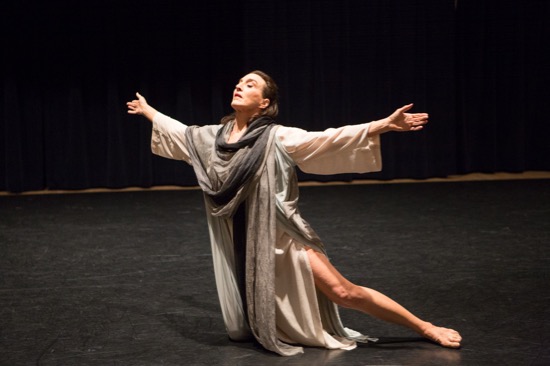
Lori Belilove in Isadora Duncan’s Mother. Photo: Yi-Chun Wu
At times during the afternoon, I miss the sense of weight you can infer from sketches of Isadora in motion and which Annabelle Gamson, her interpreter of several decades ago, was so wonderfully able to convey. I feel it in Lori Belilove’s somber and sensitively articulated Mother, the ca. 1924 solo to Scriabin’s Piano etude Op. 2, No. 1, a dance in which Isadora mourned the terrible accidental death of her two children. Catherine Gallant, in another “Russian” piece, Revolutionary, set to another Scriabin etude (Op. 8, No. 12), conveys power, not just by strength, but by the way she plunges to her knees.
I also admired the way Belilove built her advance toward the audience in her staging of Isadora’s popular ca. 1902 rendition of Strauss’s “The Blue Danube.” Beginning with light, fluid, barely traveling waltz steps, she gradually becomes warmer and more ecstatic as she comes close to us. And dancing to Loretta Thomas’s staging of Chopin’s Mazurka in D major, Op. 33, No. 2, Jessie King, Ella Lang, and Amelia Sanders give their fleet sautés an earthy impetus.
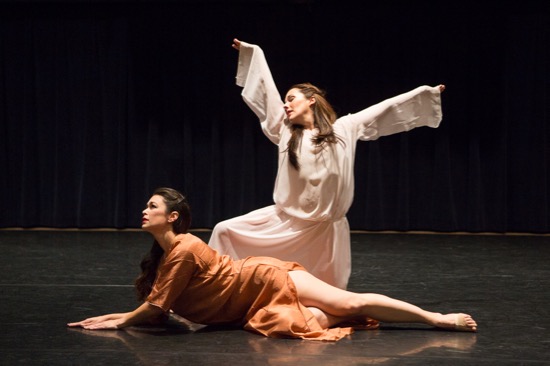
Michelle Kickasola (in white) and Ivette Sotomayor-Adrien of the Isadora Duncan Dance Ensemble in Nocturne in E flat major. Photo: Yi-Chun Wu
Duncan may have interpreted her solos differently on different occasions, but many of them are dramatic, sometimes even suggesting the emotions depicted in silent movies. Often the dancer seems to challenge or flirt with, or retreat from something she sees, or senses, beyond the confines of the stage. Bresciani performs Death and the Maiden, set to Chopin’s Mazurka, Op. 33, No. 4, with the tragic terror and fatal attraction that her inevitable destiny entailed. During second part of the program, Michelle Kickasola of the IDDE tries gently to revive Ivette Sotomayor-Adrian. The music is one of Chopin’s nocturnes (in E-flat major, Op. 9, No. 2). She barely gets the fallen one to her feet before dancing beckoningly off; Sotomayor-Adrian pursues willingly but uncertainly.
The semi-Grecian tunics enhance the carefree nature of some of the works. The panels of white china silk that serve as sleeves for Kickasola billow in her wake as she spins or travels toward and away from us to Chopin’s Étude in A flat major, Op. 25, No. 1. But the more confining red dress worn by the eloquent Sotomayor-Adrian for the composer’s Waltz in C sharp minor, Op/ 64, No.2 seems short and reveals (distractingly) a little too much of her flesh-colored underwear.
The program is scrupulous about giving the family tree of the dances shown, but it’s hard to be sure if Isadora choreographed all of them, rather than Irma. However, given the name of the program, I perhaps shouldn’t quibble over the way it bends history. Duncan was a soloist, accustomed to being alone onstage; she didn’t, I believe, perform with her “girls,” although she might stand onstage surrounded by the dancing children she taught. Also, men didn’t appear in her dances. The program states that it was her wish to incorporate them, but as far as I know, the little boys she first recruited for her school turned out to be hellions, and she let them go and never looked back.
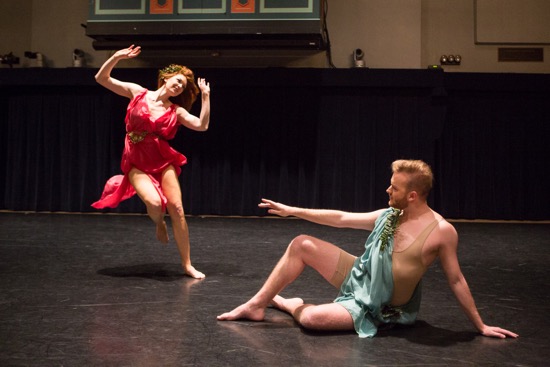
Rosemary Cooper and Peter Hraniotis of the Isadora Duncan Dance Institute in Bacchanale. Photo: Yi-Chun Wu
Nevertheless, Bresciani has a winning, go-for-it man in her company and takes the liberty of pairing sharply delicate Sasha Lehrer with zesty Peter Hraniotis in Butterfly. To music from Schubert’s 34 Valses Sentimentales, D. 779, Op. 50, she flirts, he ardently pursues. Hraniotis also appears in Bacchanale, set to three dances from Gluck’s operas Iphigénia en Aulide and Iphigénia en Tauride (and definitely an audience favorite). Tall Rosemary Cooper, vines in her long red hair, awakens the slumbering Hraniotis, and together they lead four maenads ready for the feasting and the wild dancing: Ava Cilia, Lehrer, Eva Pullano, and Ruth Rose Rae (costumes by Karen Sanders). Isadora might have been shocked by a man among the nymphs. And taken Hraniotis home with her.
Another man, Forrest Hersey, performs with six red clad women and their leader, Jucovy, in one of the dances that Isadora and/ or Irma (?) made in Russia between 1921 and 1924. To a recording of the revolutionary folk song “Dobinushka” by the Soviet Army Chorus, they mime pulling strenuously on invisible ropes that stretch from corner to corner, thudding their heels against the floor to accent their unison effort. The Alexandroff Ensemble’s Red Army Choir accompanies the evening’s most powerful dance with “Varshavianca,” whose opening lines could be translated into English as “Let us boldly raise our banner,/ Even though a storm of hostile elements howls./ Even though sinister forces oppress us today,/ Even though our tomorrow is uncertain.”
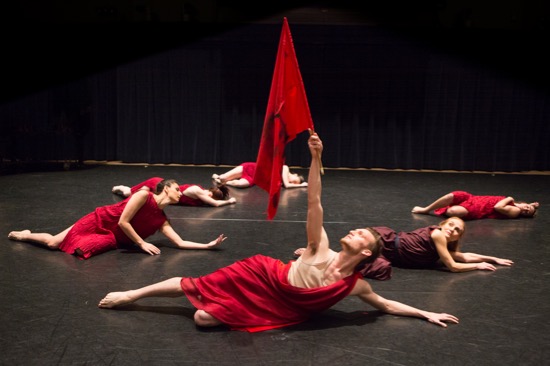
Varshavianka. Dance Visions NY’s Forrest Hersey holding up the flag. Behind him (L), Vanessa Ferranti, Cathleen Deutscher Louisa Armstrong and (R) Beth Jucovy, and Anastasia Benedetti. Photo: Yi-Chun Wu
The structure is simple. The dancers advance in a phalanx, one of them holding a red flag. This leader is hit by gunfire and falls backward; another takes the flag from her dying hand. But they march on until everyone, one at a time, has taken up the banner and crumpled to the ground. Then, slowly, one person revives, and they rise, indomitable to march again. When it was over, the woman on my right said incredulously to her companion, “I’m crying.” So was I.
It’s too bad that that persistent, but tragic advance didn’t end the program. Perhaps Seidel thought that a more upbeat vision was required. So stern Loretta Thomas leads eight women (including Gallant, who staged the piece) through Chopin’s “military” Polonaise in A major, Op. 40, No. 1. Feet step, fists are raised. Afterward, every dancer involved in the program joins in scattering rose petals as Isadora did before the First World War 1910 to Brahms’ Waltz in A major, Op. 39, No. 15, and, finally, they take a well-deserved bow.
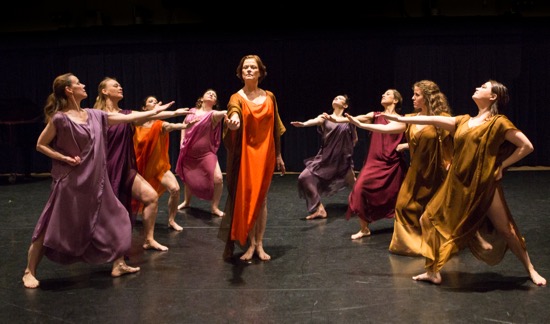
Polonaise in A major. Surrounding Loretta Thomas, (L to R) Eleanor Bunker, Marie Carstens, Michelle Cohen, Francesca Todesco, Jessie King, Catherine Gallant, Charlotte Hendrickson and Erica Lessner of Dances by Isadora. Photo: Yi-Chun Wu
Midway through the evening, Seidel spoke again and with immense conviction. She mentioned the long-ago fight for women’s suffrage, Bolshevism, and a possible Russian threat (without mentioning a name). She also talked of a young dancer who, years ago, suffered a terrible accident that necessitated amputating her leg and fitting her with a prosthesis; a dream encounter with Isadora gave her the determination to recover and perhaps dance again. We, said Seidel, must be prepared to “heroically resist” and to preserve “the preciousness of the earth.”
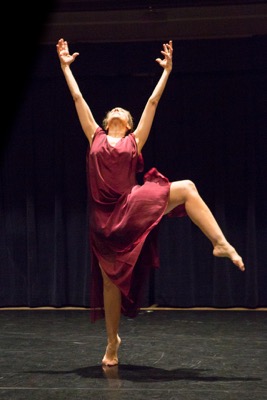
Catherine Gallant in Isadora Duncan’s Revolutionary. Photo: Yi-Chun Wu

Dear Deborah:
I am writing to thank you for your most thoughtful and insightful review. I especially appreciate that you took the time and consideration to mention all the artistic directors and our companies and to appreciate all of our contributions, without demeaning some and elevating others. My intention in helping to organize this event with the 92nd Street Y was indeed to create a sense of unity and comraderie among the various Duncan practitioners in NYC, especially important in that the event fell on inauguration day (the dawn of the evil empire). Duncan’s philosophy and ideals have a potent relevance today as you know and it was her message of hope and light that I endeavored to communicate as a priority.
I totally agree with you that Varshiavianka should have ended (I frequently ended my own concerts with this work) and had put that preference forward. However, there were many complex issues that arose with regard to programming and I deferred ultimately to Catherine Tharin as curator on this.
On another note, thank you for all your invaluable contributions to Duncan’s legacy. Your chapter on Duncan in Time and the Dancing Image is a classic and for all my students, absolutely required reading!
Wishing you all the best and many more fruitful years of happy dance-going and brilliant writing,
Andrea
I am writing to thank you for your most thoughtful and insightful review. I especially appreciate that you took the time and consideration to mention all the artistic directors and our companies and to appreciate all of our contributions, without demeaning some and elevating others. My intention in helping to organize this event with the 92nd Street Y was indeed to create a sense of unity and comradery among the various Duncan practitioners in NYC, especially important in that the event fell on inauguration day (the dawn of the evil empire). Duncan’s philosophy and ideals have a potent relevance today as you know and it was her message of hope and light that I endeavored to communicate as a priority.
Indeed, we accomplished a wonderful sense of unity and great comradery on that day. With your astute writing, I believe you sensed the egalitarian goals of our effort and the need for light and healing on a very dark day.
More generally, I also appreciate that you understand very well the power that a critic has with regard to careers, and I respect that you use that “power” sensitively and responsibly, with love and appreciation for the art form. Thank you as well for all your invaluable contributions to Duncan’s legacy. Your chapter on Duncan in Time and the Dancing Image is a classic and for all my students, absolutely required reading!
Wishing you all the best and many more fruitful years of happy dance-going and brilliant writing.